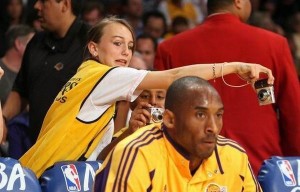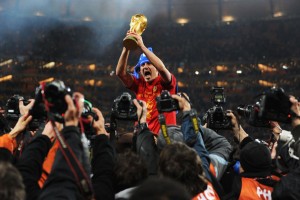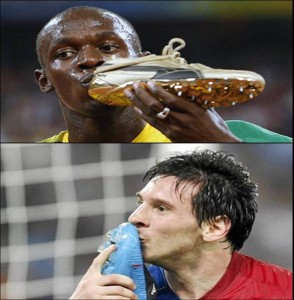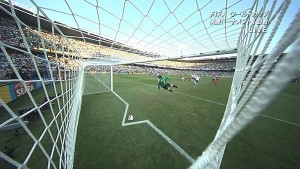 The world is changing rapidly and from now onwards the speed of that change is only going to further increase. We’re daily bombarded with thousands of images. Every photo can be worth a thousand words. But which images are the ones that stick and make a difference? Which (and whose) story is being told (and where) has almost become as important as the quality of the image. Choices about which professional images are created are increasingly made by executives, not necessarily creatives. At the same time, anyone can now take pictures. The quality of a sports photography image is no longer defined by its resolution or razor sharp focus. A picture made by a fan can travel all over the world and end up on the international front pages before you can say ‘bong’.
The world is changing rapidly and from now onwards the speed of that change is only going to further increase. We’re daily bombarded with thousands of images. Every photo can be worth a thousand words. But which images are the ones that stick and make a difference? Which (and whose) story is being told (and where) has almost become as important as the quality of the image. Choices about which professional images are created are increasingly made by executives, not necessarily creatives. At the same time, anyone can now take pictures. The quality of a sports photography image is no longer defined by its resolution or razor sharp focus. A picture made by a fan can travel all over the world and end up on the international front pages before you can say ‘bong’.
This post covers the changes in sports photography from the perspective of the photographers, media, sponsors, fans and athletes. Its not intended as a philosophical reflection of the value of a photograph. The digital revolution, which this blog is dedicated to, has resulted in lasting behavioral change as well as the way sports imagery is produced, distributed, and ultimately consumed. How do photographers find their audience, how do sponsors maximize their visibility, and how do athletes manage their exposure?
Photographers: Artists, Reporters or Editors?
The key application of professional sports photography is for editorial purposes; dedicated sports photographers generally work for papers, major wire agencies, or dedicated sports magazines. However, sports photography is also utilized for advertising purposes both to build a brand as well as to push a sport in a way that cannot be achieved by editorial means. Despite the fact that camera manufacturers have dramatically reduced the difficulty of focusing and nailing exposure, the photographer IS the difference between ‘just any picture’ and a great picture. Whether you’re shooting action, commercial, feature, or portrait photography the underlying image structure, composition, dodging and burning (selective lightening and darkening), gesture, color and originality of an image celebrate the true skill of a talented photographer.
One of the single most difficult aspects of being a sports photographer is to capture the “decisive moment”. It involves a deep understanding of the sport and what is newsworthy. The media are looking for news, the decisive moment, perfectly illustrating the story of that game. It’s all about the goal or the sending-off. Capturing that moment requires experience, anticipation, skill, and probably even a little bit of predicting the future.
Technology
However, in a couple of years from now, there might not be a shutter to press anymore. Some camera models are now processing “image capture” before you depress the shutter – enabling recall of prior moments even before you’ve shot the image. This technology is becoming available in consumer cameras like the new Nikon 1. According to French American photographer Vincent Laforet , @vincentlaforet, technological developments are leaning strongly towards further convergence between the photo and the film camera. Current cameras capture up to120 (!) frames per second (at an incredible resolution). Stills from video might not be good enough for usage yet, but they soon will be. Due to increases in quality and file size, it’s the storage and delivery which is now sometimes problematic. Original files are too large to even email, so Media Manager solutions are becoming more prevalent. In the near future cameras will simply be recording all the time, thus evolving the job of capturing “the moment” into editing it. There’s going to be such an incredible amount of data coming in that editor is going to become one of the most important job positions out there.
Google images and Flickr are rapidly turning great imagery into a commodity. How would you have searched for images before those platforms, or rather; were you even looking for images in the first place? Today images of professional photographers quickly find their way into a wide variety of social channels and they should think carefully about the risk of losing control over their photographs. Who actually owns these photos in social media? Some agencies like WENN own the rights to all imagery uploaded to Twitter via the TwitPics app. Creators of this unique content may be giving away their rights without even knowing this! It’s all in the small print. Kathy E Gill (@kegill) formulates an insightful answer to this rather complicated question in this great post.
On the back of digitally enhanced films like 300, the post-production of imagery is rapidly increasing in importance. 3-D photography has been around since the early 1900’s, but it’s only now that we have the applications to use the content for consumers through cinema, tv, mobile phones, tablets, etc. Another new technological option is the 360 degrees photography panoramic image, (which could also have relevance to sports). A 360 pan of a big play in the endzone of the Superbowl would be awesome! Maybe we should be holding out until this is available.
Distribution & Global Sports Events
Pictures are distributed worldwide and no longer geographically constrained. The big agencies, such as Reuters, Associated Press, and Getty Images are dominating the photography marketplace worldwide. In sports photography access is the key. Without proper accreditation, entering and photographing at a major sports event has virtually become impossible. Getting hold of these accreditations is increasingly challenging. The question is whether that is a problem. I personally do not think so. How many photographers does it take to photograph the world’s largest sports event? The 2010 FIFA World Cup hosted exactly 943 accredited photographers from all over the world. The 2010 FIFA World Cup final was covered by 233 photographers on the pitch and an additional 128 on the tribune.
 The choreography following the final whistle in a Champions League or World Cup final has become a returning comedy. Dozens of stewards run around the field holding cords in an attempt to ‘cage’ the photographers. At the same time dozens of photographers fight each other for what they believe is ‘the best place’ to shoot their shot. This system basically facilitates that the (physically) strongest photographer is allowed to shoot from ‘pole position’.
The choreography following the final whistle in a Champions League or World Cup final has become a returning comedy. Dozens of stewards run around the field holding cords in an attempt to ‘cage’ the photographers. At the same time dozens of photographers fight each other for what they believe is ‘the best place’ to shoot their shot. This system basically facilitates that the (physically) strongest photographer is allowed to shoot from ‘pole position’.
Of course I highly respect and greatly appreciate the dedication, perspective, artistic eye, and sense for news that most individual photographers bring to their work. They’re extremely passionate about their photography and really into their sport. However, one wonders if we are approaching the point where the sheer amount of photographers becomes directly detrimental to quality of the photography. Does more really result in better? In the meantime, changes seem inevitable.
Click here for a tutorial with sports photographer Craig Golding (sponsored by Canon) or here for the Getty Images Blog which highlights a whole host of events, photographers, and shoots. In this one created last week, sports photographer Dean Moutharopoulos talks about shooting boxing.
Sponsors: “If you do not shoot, you cannot score!”
Although Dutch soccer legend Johan Cruijff was talking about soccer in this ‘Yoda-like’ quote above, his words are equally appropriate for today’s topic. Simply put: photography that isn’t shot will never be seen. Sponsors often (also) aim for maximum exposure, and photography that remains un-shot, in many cases, equals missed opportunities.
Hiring famous or influential people to represent your products is not enough to create a deep and true connection. It’s also why sponsors use strong imagery to equate products with positive cultural and social experiences. There have been many shots that have emulated a star in their own sport from Michael Jordan’s many clutch shots to David Beckham bending in one of his legendary free-kicks. Sponsors connect their brand and /or their product(s) with events and individuals, using imagery to equate products with positive cultural and social experiences. The images we perceive take these associations out of their representational realms and make them live realities. Simply put, “If I wear the same football shoes as the world’s best player, I’ll probably be a better athlete”.
I Heart My Sponsor
 Whether it’s Jamaican Usain Bolt kissing his Puma Complete Theseus II spike at the 2008 Olympic Games, or Leo Messi kissing his adidas Adizero F50’s in the UEFA Champions League final, a well-timed, authentic image celebrating the athlete as well as a sponsor’s product can make all the difference. Research shows that strong brand imagery, in particular images of ‘celebrational athletes’ , results in the most favourable brand-associated coverage achievable.
Whether it’s Jamaican Usain Bolt kissing his Puma Complete Theseus II spike at the 2008 Olympic Games, or Leo Messi kissing his adidas Adizero F50’s in the UEFA Champions League final, a well-timed, authentic image celebrating the athlete as well as a sponsor’s product can make all the difference. Research shows that strong brand imagery, in particular images of ‘celebrational athletes’ , results in the most favourable brand-associated coverage achievable.
At the world’s largest sports events photographers are usually well represented. While sponsors might not have to worry about imagery being shot, they do have to ensure the capability, structure, rights, and process to allow immediate, integrated activation of such tactical opportunities.
Measuring Results
Thoughtfully executed evaluations allow sponsors to formulate meaningful and measurable objectives. Usually such objectives would include visibility, favorability, and reach in a previously defined media sample. Such research is able to monitor a brand’s ongoing performance on a daily basis, over consecutive quarters, or year to year. It also allows them to compare their performance vs. its main competitors or its fellow sponsors.
Depending on its objectives, a brand can choose to monitor the use of photography and the impact its use has on the favorability of the coverage. Also tracking which images get used where will allow sponsors to develop the creation and distribution of their images.
Media: Destination or Distribution?
The internet is a key influence on the future of photography as we know it. Editorial photography is in the doldrums; magazine and newspaper publishing is going down. The quality, news value, or printability of an image is no longer defined by its resolution, and distribution has become at least as important as your company-owned destination. Kids rarely read magazines; instead they spend all day on their phone or ipad. Still photography is important, Sports Illustrated’s Swimsuit edition proves it year after year and so does the annual Body Issue of ESPN.
Some of you might have already seen this video featuring a 1-year-old playing with an iPad. She then gets confused and disappointed when paper magazines don’t respond the same way to being tapped or slid on. “For my 1-year-old daughter, a magazine is an iPad that does not work”.
Sport Illustrated is an aggressive innovator in the tablet space, and photography is a key component of its strategy. As this post by Lauren Indvik (@laureni) for mashable points out, Sports Illustrated has produced a digital edition for the iPad every week since it debuted last June, produces daily content for www.si.com, and created “SI Snapshot” , a chrome app delivering the best sports pictures of the day – every day. At Time they certainly realize that great photography has the ability to ignite conversations (and drive sales). Terry McDonell (@SI_TMcDonell), the editor of the Time Inc. Sports Group explains; “We used to do 3,500 pages per year. Now we do more than 100,000 pages, maybe 200,000 if you count different aspect ratios and slideshows as pages. Digital now accounts for 30% of overall revenue. Print generates 55%, and other marketing efforts bring in 15%”. Here’s another Mashable post by Lauren on Sports illustrated.
Too Slow?
Here’s an interesting post on invocus by Brent Treworgy on how social media is changing the media landscape. His point of view is that if consumers are finding daily newspapers too slow for their liking, monthly sports magazines seem positively irrelevant!
Social media, and Twitter in particular, has had an enormous impact on sports coverage over the past five years. It’s hard to talk about breaking news on Twitter without mentioning Captain Sully and his heroic landing on the Hudson River. Twitter had the news – and the pictures – before any of the major news outlets started reporting what transpired. It brought Twitter into the spotlight as a legitimate news source. Twitter has certainly brought sports figures, those who cover them, and consumers all closer together, and opened up new channels of communication between them. While it is true that print coverage of sports has continued to suffer, social media has also allowed new business models to emerge.
Gone are the days of refreshing ESPN.com’s front page during half time of the Super Bowl. For both reporting and photojournalism there are two ways to get ahead: be the first or be the best. For most, it’s easier to be first. To break a story, a photographer has to deliver his pictures the instant they’re shot. However before distributing imagery or information you learned on Twitter – before you hit RT – check the source of the story before you become part of the problem.
Fans: You love to watch, don’t you?
Fans love autographs, re-tweets, and having their pictures taken with their favourite athletes. They literally fall over themselves to take a picture with their idol, take a moment in the middle of the coin toss or even invite the coach of the opposing team to snap their photograph . Photography is everywhere and fans are sharing 24/7.
Fans have become an important source of imagery. According to a study by Panasonic, a stunning 175 million minutes of video from the 2012 Games will be captured by fans, equal to 334 years of footage. It estimates fans will snap 466 million photos of athletes and events in London! These numbers imply that each of the 8.8 million ticket-holding Olympic fans will take 53 photographs and about 20 minutes of video.
Pretty, Partying, Planking, Police & Playboy
Athlete photography simply fascinates fans– whether it’s the top 20 of most embarrassing athletes pictures, a gallery of the 20 prettiest female athletes, athletes planking, athletes partying, pictures shot by playboy or even the police. Today every single shot is only one quick click away.
Corporate technology is now firmly in the hands of consumers. Altering imagery has become as easy as photographing itself. However the main change is not technical, it’s sociological. It’s not about the tools that have become available to all, it’s about consumer behavior that has fundamentally changed. The democratization of images has resulted in self-controlled broadcast. As an example, here’s a post by @amymaeelliott featuring 10 stunning sport photographs taken on an i-phone (some of the iphone apps for image creation are excellent) and here are 8 tips for taking better sports pictures by @dakdillon.
The 2010 FIFA World Cup
 The power of the network has turned the audience you reach into the people who are reached by the people who are reached by the people you reach (ehm, please do feel free to read that sentence once again…). A typical example is that despite the small army of 948 officially accredited FIFA World Cup photographers, the most memorable image of last year’s tournament was a viral image created by an unnamed fan. Within hours of England’s disastrous 4-1 2010 FIFA World Cup loss against Germany, the internet was awash with references to a controversial referee decision, including one doctored image featuring a white line showing just how far the ball had made it past the goal posts.
The power of the network has turned the audience you reach into the people who are reached by the people who are reached by the people you reach (ehm, please do feel free to read that sentence once again…). A typical example is that despite the small army of 948 officially accredited FIFA World Cup photographers, the most memorable image of last year’s tournament was a viral image created by an unnamed fan. Within hours of England’s disastrous 4-1 2010 FIFA World Cup loss against Germany, the internet was awash with references to a controversial referee decision, including one doctored image featuring a white line showing just how far the ball had made it past the goal posts.
These internet memes are a relatively new phenomenon, often an (altered) photograph (video, site, phrase or word). Internet memes will move from person to person via social networking websites, blogs, news sources and other web-based services. Internet memes can spread very rapidly by ‘word-of-mouse’, sometimes reaching world-wide popularity and vanishing in a few days. Incidents surrounding major sports event have proven an exceptionally rich inspiration source for memes.
Athletes & Sports Photography: Trick, Treat or Thread?
People love looking at attractive people and fans love looking at (and photographing) attractive athletes. Looks matter. With the available research it’s fair to conclude that attractive athletes make significantly more money than lesser attractive colleagues. According to this post on ABCNews by @ewencallaway better-looking sportsmen are even more likely to win matches!
While some (in most cases most) of an athlete’s income is generated by his or her athletic skills, a significant percentage of their money comes from being a public figure. Many people consider athletes’ brands. As such, athletes are not only representing themselves but also their school, team, club, league, or sponsor(s). Most athletes appreciate that most fans are genuinely interested in what is going on in their lives. Clearly none of today’s well-known athletes would be where they are without cameras.
Paparazzi
However, paparazzi are increasingly turning their attention to athletes. ESPN quotes Gary Morgan, the CEO of Splash, a paparazzi agency that employs upwards of 2,000 photographers worldwide, “Sports stars now are really the big Hollywood actors and actresses, they’re the new celebrities.” NFL prospect Colt McCoy already is keenly aware that “you got to be on your guard all the time, no matter where you are or what you’re doing, just be smart.” NASCAR’s four-time Sprint Cup champion, Jimmie Johnson, knows the tabloid world is training its eye on athletes and the “magnifying glass is intensifying in the sports world.” Athletes surely do have the right to a private life too, don’t they?
Privacy?
 A survey conducted by PR Week in the UK in September 2010 amongst 3,000 respondents showed that, in the eyes of the public, celebrities who make money from their private lives have fewer rights to privacy. 36% of respondents believed the public had the right to know about a sports star’s private life. An additional 49% (85%!) feels the public has the right to know about a sports star’s private life if “it” was something that undermined their sports performance. In addition, 68% said celebrities do not have the same rights to privacy in the future if they made money by revealing details of their private lives to the media.
A survey conducted by PR Week in the UK in September 2010 amongst 3,000 respondents showed that, in the eyes of the public, celebrities who make money from their private lives have fewer rights to privacy. 36% of respondents believed the public had the right to know about a sports star’s private life. An additional 49% (85%!) feels the public has the right to know about a sports star’s private life if “it” was something that undermined their sports performance. In addition, 68% said celebrities do not have the same rights to privacy in the future if they made money by revealing details of their private lives to the media.
That’s probably why these 2,000 paparazzi have jobs! But hey, wait a second, who’ll need paparazzi anyway?! With every second fan feeling entitled to photograph an athlete around the clock, paparazzi might quickly become obsolete. Athletes are not superhuman and – with a camera density of close to 100% – every athlete will (eventually or inevitably) be photographed under ‘sub-optimal circumstances’. As one of the world’s most famous cases, here’s a link to the NBC coverage of the Micheal Phelps ‘Bong picture’.
Watch & Learn
Not only pictures shot by fans and paparazzi are making headlines, also pictures taken by athletes such as: Brett Favre, Martellus Bennett, Dorell Wright, George Hill, Greg Oden, Sean Salisbury, Grady Sizemore, Chris Cooley, Mark Ingram, Ron Artest or Ray Edwards are creating news. It’s fair to assume their pictures were not intended for mass publication or large scale distribution.
In some of the above cases the pictures were taken years ago and shared (leaked) by trusted contacts. Nobody needs to be taught not to publicize naked pictures. Not everybody is aware of hackers stealing your private images though. According to LA Late, a man was arrested early October 2011 for committing a digital breach of many celebrities’ mobile and computing devices to steal photos and then leak them online. Officials confirmed that the pictures were being looted from traditional devices like laptops and computers, not just mobile devices like cell phones.
In retrospect, no matter how these images got out, an athlete’s assumption that his (or her) private pictures will remain unseen by the common public has clearly been proven mildly naive. Should we all agree that from now onwards a “momentary lack of judgment” and “naivety about the Internet” are no longer valid excuses? Athletes can read too and should definitely be learning from the experience of others in sports photography. Therefore the most sensible guidance to (aspiring) athletes that do not want to get “caught with their pants down” remains that the images that you do not want seen should probably never be shot.
What are your thoughts on sports photography today and social media’s impact? Let us know in the comments below and please feel free to share this article with your friends on Facebook and Twitter.
Special thanks to Brendan Kemp, aka @bjnkemp.


@doroff Check this social media guide good n cheap http://t.co/byTKiAro
@trevorturnbull I got some nice help from this http://t.co/kXxeMQvi
@shane_harmon Check this social media guide good n cheap http://t.co/lWrnQ0Sw
@thomasvanschaik Cheers Thomas. Always glad to help where I can pal. Its a great article.
@maxcowan thanks for spreading the word about our articles max!
@johnraser thanks for spreading the word about our great articles and authors john!
@oldhatjess thanks for spreading our articles!
@stijnjacobs thanks for the RT Stijn!
@dstrac thanks for the RT Dave!
@sportsnetworker You got it. I’ve been a fan of @LewisHowes & @sportsnetworker for years. Keep pumping out strong content!
@sportsnetworker My pleasure … nice article
@P2Sports thanks for the tweet & following @sportsnetworker !
@Stephen_Cleary @avanschendel thanks for following @sportsnetworker and your tweets!
@thomasvanschaik Start my 6 month digital football marketing internship with adidas in A’dam next month. Hopefully we cross paths Thomas 🙂
@Stephen_Cleary am convinced we will. Congrats on the oppertunity, welcome to Amsterdam & the adidas team!
@thomasvanschaik Thank you, can’t wait to start
@stephaniejerzy thanks for spreading the article stephanie!
great article Thomas!
@sportsnetworker sure thing, it was a good late lunch read today!
I just started buying garments for my own babies on the web almost a year ago and its saved my family
so much money, my own most significant worry was clothes fitting but
if you discover a online store with a decent returns policy then you should not have any troubles
each time i used to read smaller articles or reviews
which also clear their motive, and that is also happening
with this post which I am reading now.
Bon je vais en parler sur un blog
Puis-je prendre deux-trois lignes pour mon site internet personnel ?
Hey There. I found your blog using msn. This is a very well written article.
I’ll be sure to bookmark it and return to read more of your useful
information. Thanks for the post. I’ll certainly return.
I was pretty pleased to discover this web
site. I need to to thank you for your time just for this wonderful
read!! I definitely savored every little bit of it
and i also have you book-marked to see new things on your website.
Pesona Pantai Jakat Primadona adalah wisata yang diincar turis akan keindahannya dan menjadi destinasi wisata terpopuler di Bengkulu.
Tempat rekreasi di Bengkulu banyak yang memikat. Diantaranya yang demikian bintang di Bengkulu yakni Pantai Jakat.
Walau sebenarnya ada beberapa faktor yang mengakibatkan pintu tidak tertutup secara otomatis lho, seolah ada orang berdiri begitu dekat dengan pintu, tombol stop yang tidak menyengaja tertekan, atau penumpang yang paling sering. Kebayang tidak sich bagaimana cocok jam sibuk? Bis penuh, semua penumpang cepat-cepat, tetapi bis tidak dapat jalan karena pintunya tidak tertutup.
Coba bandingkan dengan bis di Indonesia, kopaja misalkan. Kopaja memiliki dua pintu yang bertangga. Maksudnya adalah kita selalu tiap langkah kaki kita. Jika tidak jadi perhatian, dapat jatuh.